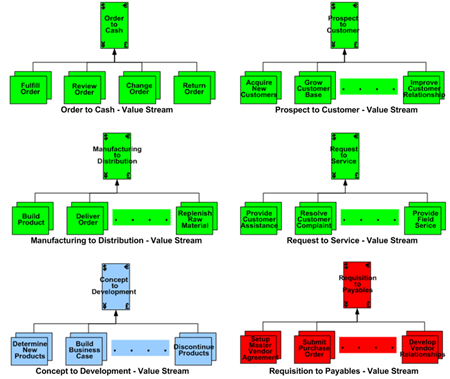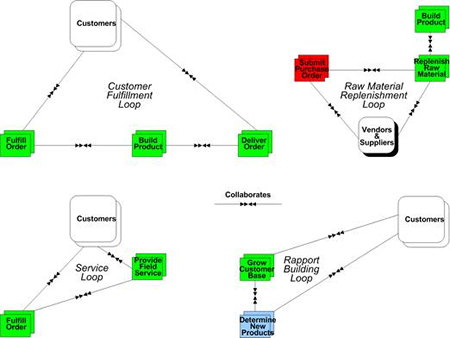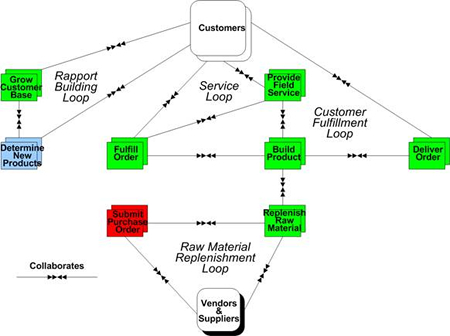One basic tenet of the Business Architecture (BA) is that it represents the enterprise wide integration of all business processes resulting in the Business Architecture model itself. Perhaps some business and IT professionals place more emphasis on the strategic BPM initiatives, but eventually; all business processes are integrated in the BA. In many cases, the strategic BPM initiatives represent key end-to-end processes or value steams; the building blocks of the enterprise. These building blocks, in a metaphorical sense, are similar to a bill of materials (BOM) for a manufactured product. A BOM is hierarchical in nature with the top level representing the integration of all components; the embodiment of the finished product. The enterprise or business unit is quite similar in that it has that metaphorical BOM, but it is called a “bill of value streams.” And the top level represents the integration of all value streams, thus creating a blueprint of the enterprise. This blueprint is a static model that describes numerous relationships, links and connections between the integrated value streams. Decomposition of the value streams exposes the operational behavior of the enterprise into high-level and detailed business process models, usually linear in presentation. These decomposed models are dynamic in nature and describe the various workflows the BPM initiatives undertook in order, for example, to improve performance and efficiency.
Examination of the value streams within the BA through its decomposed high-level business processes reveals the information presented in Figure 1. This model decomposes six of the sixteen value streams found in a generic build-to-order manufacturer. The value streams decompose into high-level business processes, with the relevant ones for this discussion illustrated Figure 1. Readers wishing to examine the BA case study example[1] from which Figure 1 was derived and built are encouraged to review the one found within the embedded link. Please use Internet Explorer as the navigation and hyperlinks are configured for this browser; other browsers do not support the navigation and hyperlinks.

Figure 1 –Value Streams Decomposed into High-Level Business Processes
One can build a complementary business view using Figure 1 to illustrate the relationships and to a certain degree, the flow of information between several high-level business processes. The view portrayed in Figure 2 assembles a structure of complex associations from an understanding of the relationships in the “bill of value streams.” Please understand the “collaborates” construct used in Figure 2 represents the exchanges of inputs/outputs, and it necessarily reduces the detail and complexity of the model for the purposes of review in this article.
The reader is encouraged to follow the creation of Figure 2 as described below:
- The upper left section of Figure 2 illustrates the relationships between the Customer and some high-level business processes from the Order to Cash and Manufacturing to Distribution Value Streams.
- The upper right section of Figure 2 illustrates the relationships between the Vendors & Suppliers, and some high-level business processes from the Manufacturing to Distribution and Requisition to Payables Value Streams.
- The lower left section of Figure 2 illustrates the relationships between the Customer and some high-level business processes from the Order to Cash and Request to Service Value Streams.
- The lower right section of Figure 2 illustrates the relationships between the Customer and some high-level business processes from the Prospect to Customer and Concept to Development Value Streams.

Figure 2 – High-Level Business Process Relationships
Even though business processes generally represent workflows in a linear fashion, Figure 2 represents a set of more complex relationships. These newly realized complex relationships built or assembled from the Business Architecture do NOT describe the sequence of one core cross-functional business process followed by another, then another, and so on. It is more accurate to describe these complex relationships as a “set of integrated loops” revealing interrelationships underlying complexity; a significant scope expansion up from linear thinking. This “set of integrated loops” is presented in a composite view in Figure 3. Through careful analysis, one can develop strategic insights into what the enterprise might achieve by understanding these complicated interrelationships. One might recognize that the complementary business view constructed from the BA provides a “systems thinking” view as defined by Peter Senge: “Systems thinking is a discipline for seeing the structures that underlie complex situations and for discerning high from low leverage change[2].” In this case the “whole” is the enterprise or business unit currently undergoing analysis using the integrated business processes in a Business Architecture model.

Figure 3 – A Set of Integrated Loops
Figure 3 goes well beyond “linear thinking;” there is neither a sequence to follow nor marked starting/ending points. Rather what Figure 3 represents is a “systems thinking” view representing the integration of decisions and actions across many independent business processes; somewhat overwhelming to “linear thinking.” Just consider the possibilities and relationships between the loops. For example, through successful marketing and development of customer relationships, the Rapport Building Loop might activate several Customer Fulfillment Loops. After numerous Customer Fulfillment Loops, the Raw Material Replenishment Loop is activated in order to keep the production lines fully operational. And then a happy customer might then consider using the build-to-order manufacturer to perform routine product maintenance and servicing which activates the Service Loop. And so on and so on with countless variations in the activations of these loops and other enterprise loops. Readers not familiar with a build-to-order manufacturer might find this discussion a bit confusing. After all, this kind of enterprise complexity is hard to convey and cannot be reduced to a modest number of sequential steps in a linear process model. This kind of analysis is enabled and enhanced by a Business Architecture model and a “systems thinking” view.
It is too optimistic to expect spur-of-the-moment decisions on priorities for strategic initiatives from this high level overview of a “current state” model, but realizing where breakthrough opportunities await discovery is a common expectation. In reality, the multitude of linkages, connections, requirements, performance expectations and complex relationships will demand meticulous exploration and careful scrutiny of the model’s components, their resources and supporting organizational teams. And understanding “feedback, how actions reinforce or counteract (balance) each other[3]” is required along with the supporting metrics and measures for success. Also, consider business intelligence analysis, not only between processes and value streams, but between the newly revealed dependencies of the loops as well. This is where the real work begins in examining the flows, two-way exchanges of inputs and outputs, and other interdependencies in order to achieve additional performance improvements, higher levels of customer satisfaction and competitive advantage[4].
Perhaps one very real opportunity with the Business Architecture is the beginning of “systems thinking” rather than the end of linear thinking as the title of this article implies. One can better understand the enterprise or business unit by contemplating the whole and its complex relationships, rather than by looking at one or two individual processes, functions or organizations. Is a “systems thinking” approach with the Business Architecture the new behavior for the enterprise? Hopefully, the reader says yes!
References
- Enterprise Business Architecture web site: Enterprise – Hierarchy
- Peter M. Senge, The Fifth Discipline: The Art & Practice of The Learning Organization (Doubleday 1990), page 69.
- Ibid., page 73.
- See Whittle, Ralph, “Building Competitive Advantage Using the Enterprise Business Architecture”, Cutter IT Journal, Value Chain Modeling, April 2011.

















